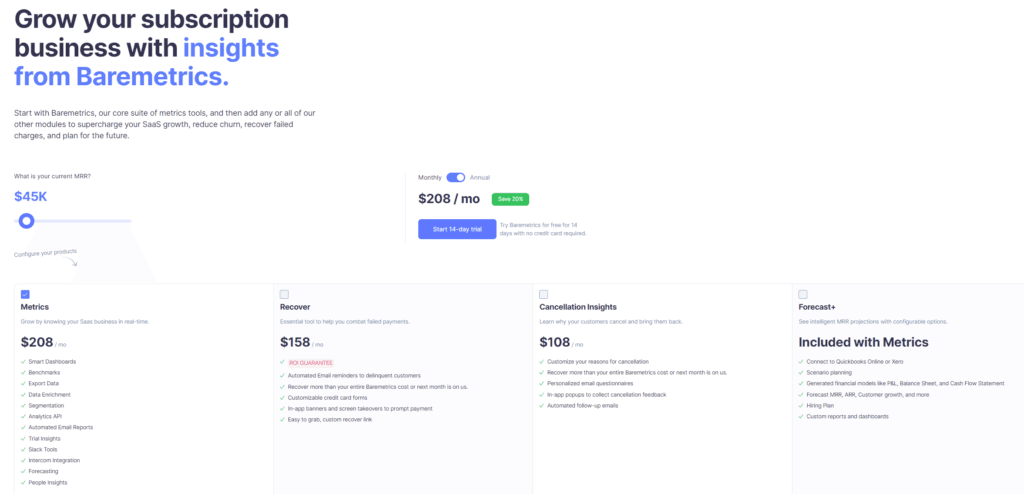In the vast ocean of data that modern businesses swim in, choosing the right analytics tool is like picking the perfect boat. It can either sail you smoothly towards insights and growth or leave you adrift in confusion. Today, we’re zoning in on two formidable vessels in this sea of data: MicroStrategy and Baremetrics. If you’re standing at the crossroads trying to decide which path will lead you to treasure, you’re in the right place.
| MicroStrategy | Baremetrics |
|---|---|
 |  |
| G2 Score – 4.2 out of 5 stars | G2 Score – 4.6 out of 5 stars |
| TrustRadius Score – 8.4/10 | TrustRadius Score – 10/10 |
Ease of Use and User Interface
Why It Matters
.Diving deeper into the realm of analytics tools, the conversation around ease of use and user interface (UI) takes center stage, and for good reason. In a world where time is of the essence, and decision-making needs to be swift, navigating through complex data should feel like a breeze, not a chore. This is where the stark differences between MicroStrategy and Baremetrics become even more pronounced, painting a vivid picture of how each tool caters to its audience.
MicroStrategy: The Power Player
MicroStrategy is like the Swiss Army knife of analytics tools. It’s robust, packed with features, and can cut through the thickest data forests to give you the insights you need. However, with great power comes a steep learning curve. New users might find themselves a bit overwhelmed by the array of options and the somewhat corporate-feeling UI. It’s not that it’s unfriendly; it’s just that it’s designed for users who live and breathe data.
Navigating through its extensive dashboard offerings and data visualization tools can feel like mastering the control panel of a submarine. It’s all there for a reason, and each button and dial has its purpose. But it might take some time to learn what every lever pulls. Once you get the hang of it, though, MicroStrategy becomes an indispensable tool for deep data analysis.
Baremetrics: The Friendly Guide
Baremetrics, on the other hand, feels like your friendly neighborhood coffee shop where everyone knows your name. Its UI is clean, inviting, and designed with a clear focus on user experience. From the get-go, you’re greeted with a dashboard that feels more like storytelling than number-crunching.
For startups and small to medium-sized businesses, Baremetrics shines as a beacon of simplicity. It integrates seamlessly with popular payment platforms like Stripe, Paypal, and others, pulling your financial data into easy-to-understand metrics and dashboards. There’s hardly any setup involved; it’s almost plug-and-play. This doesn’t mean Baremetrics lacks depth. It offers powerful insights into revenue, customer behavior, and more, but it serves them in a way that’s digestible without a data science degree.
Data Integration Capabilities
The Foundation of Insights
When venturing into the critical aspect of data integration capabilities, we delve into a core functionality that defines the operational efficiency and analytical depth of any analytics tool. This area, pivotal for understanding the seamless interconnectivity between disparate data sources and the analytics platform, underscores the breadth and depth of analysis that businesses can achieve. MicroStrategy and Baremetrics stand on different grounds, each addressing this functionality with a distinct approach that caters to their respective audiences.
MicroStrategy: The Industrial Port
MicroStrategy emerges as a colossus in this realm, equipped with a formidable array of connectors and adapters designed to bridge the vast expanse between it and virtually any data source one can imagine. From traditional relational databases to modern cloud-based services and everything in between, MicroStrategy’s integration capabilities are built to encompass a wide spectrum of data environments.
This universality ensures that organizations, regardless of their data infrastructure, can leverage MicroStrategy as a central hub for their analytics endeavors. The platform’s prowess in data integration is not just about the sheer volume of connections it can establish but also about the depth of integration. It allows for a seamless flow of data, ensuring that the analytics performed are comprehensive and reflective of the entire organizational ecosystem. This level of integration is particularly beneficial for large enterprises that operate across multiple data systems and require a unified view for decision-making.
Baremetrics: The Convenient Marina
Conversely, Baremetrics focuses its integration capabilities with precision, targeting the SaaS sector with a streamlined approach. Its integration suite, though less extensive than MicroStrategy’s, is profoundly effective in its domain, offering direct connections to popular payment platforms and SaaS financial tools. This targeted approach allows Baremetrics to provide real-time insights into critical financial metrics such as MRR, ARR, churn rates, and customer lifetime value, among others.
The beauty of Baremetrics lies in its ability to deliver these insights through a plug-and-play model, minimizing setup time and complexity. This efficiency makes it an ideal choice for SaaS businesses and startups that operate on leaner resources but require immediate and clear insights to drive growth. Baremetrics excels in making the data integration process as painless as possible, ensuring that even those with minimal technical expertise can easily connect their data sources and start deriving value from their analytics.
Integration Capabilities
The Importance of Being Integrated
Delving deeper into the realm of integration capabilities reveals a landscape where the paths of MicroStrategy and Baremetrics diverge, each forging its route based on distinct philosophies and target audiences. The significance of integration capabilities in analytics tools cannot be overstated, as it is the foundation upon which data from various sources is transformed into coherent, actionable insights. This process is akin to weaving a tapestry, where each thread represents a different data source, and the quality of the final image depends on how seamlessly these threads are woven together.
MicroStrategy: The Universal Connector
MicroStrategy, with its expansive view towards data integration, positions itself as a master weaver, capable of integrating a broad spectrum of data sources. This capability is a testament to its enterprise-focused design, which anticipates and accommodates the complex data ecosystems characteristic of large organizations. The platform’s ability to connect with an array of data sources, from legacy databases to modern cloud applications, reflects a deep understanding of the varied nature of enterprise data environments.
Through these connections, MicroStrategy facilitates a unified analytics experience, drawing together disparate strands of data into a single, coherent whole. This comprehensive approach to integration enables organizations to harness their entire data landscape, turning isolated data points into a symphony of insights that drive strategic decision-making.
Baremetrics: Streamlined for SaaS
Contrastingly, Baremetrics adopts a more focused approach to integration, honing in on the specific needs of the SaaS sector. This specialized strategy eschews the broad integration landscape for a targeted set of connections that are most relevant to its audience. By directly integrating with key payment platforms and financial services, Baremetrics offers a seamless conduit for SaaS metrics and financial data. This direct line to essential business metrics enables SaaS companies to quickly and effortlessly glean insights into their financial health, customer behavior, and growth trends.
The streamlined nature of Baremetrics’ integrations exemplifies its commitment to accessibility and efficiency, ensuring that even businesses with limited technical resources can tap into the power of data analytics without the need for extensive setup or configuration. This approach not only simplifies the data integration process but also aligns perfectly with the agile, fast-paced environments of startups and small businesses.

Related: Check out our free SEO suite

Customization and Flexibility
Navigating the Seas of Customization
In the voyage through analytics tools, the aspects of customization and flexibility are akin to setting the sails of a ship, determining how swiftly and effectively one can navigate through the waters of data analysis. Customization in analytics tools speaks to the ability to tailor the platform to the unique needs and workflows of a business, while flexibility reflects the tool’s capacity to adapt to changing data landscapes and business requirements. Let’s compare how MicroStrategy and Baremetrics handle these critical aspects, guiding you through the choppy waters of data analytics to smoother seas.
MicroStrategy: The Architect’s Dream
MicroStrategy stands tall as a beacon of customization and flexibility, offering its users the architectural tools to construct a highly tailored analytics environment. This platform is like clay in the hands of a sculptor, offering an almost limitless potential for customization. Users can design dashboards and reports that align perfectly with their operational workflows, ensuring that every piece of analysis is not only insightful but also actionable within the specific context of their business.
Moreover, MicroStrategy’s flexibility is evident in its ability to adapt to both the scale and complexity of enterprise data needs. Whether it’s adjusting to new data sources, evolving business processes, or changing compliance requirements, MicroStrategy offers the robustness needed to maintain agility in a corporate setting. This level of customization and flexibility is particularly valuable for large organizations with complex analytics needs, allowing them to mold the tool to their precise specifications and ensuring that their analytics infrastructure can grow and evolve along with the business.
Baremetrics: Simplicity Meets Adaptability
Baremetrics, on the other hand, takes a different tack. Its customization and flexibility are not about building from the ground up but rather about providing a highly intuitive and adaptable platform that caters to the needs of startups and SaaS businesses. The customization available within Baremetrics is centered around simplifying the complex world of data analysis, making it accessible and immediately useful to its users. This means offering a range of predefined, but customizable, dashboards and metrics that directly address the core concerns of its audience, such as MRR, churn rate, and customer lifetime value.
Flexibility in Baremetrics is reflected in its ability to quickly integrate with new services and adapt to the rapidly changing landscapes of SaaS businesses. While it may not offer the same depth of customization as MicroStrategy, Baremetrics prioritizes adaptability through its ease of use and the straightforward manner in which users can derive value from their data. This approach ensures that even as a business grows or shifts direction, it can continue to rely on Baremetrics for clear, actionable insights without the need for extensive reconfiguration or IT intervention.
Cost and Pricing Structures
Understanding the Price of Insight
In our exploration of analytics tools, cost and pricing structures emerge as crucial harbors for consideration. After all, the investment in an analytics tool is not just about the price tag; it’s about the value it brings to your business. Let’s navigate through the financial waters of MicroStrategy and Baremetrics to see which offers the best value for your needs.
MicroStrategy: The Enterprise Investment

MicroStrategy’s pricing is akin to charting a course for a large vessel. It’s built for enterprises, which means its pricing structure is tailored to support extensive analytics capabilities across large teams and data volumes. The cost is substantial, reflecting the depth, power, and scalability of the platform. MicroStrategy doesn’t publicly list its prices, which is common for enterprise-level software. Instead, it offers customized pricing based on the specific needs and scale of each business.
This approach allows for a tailored fit to your organization’s requirements but also means the investment can be significant. The upside is clear: comprehensive analytics capabilities, extensive support, and a platform that can scale with your business’s growth. For large organizations that can leverage its full potential, MicroStrategy represents a significant but valuable investment in data-driven decision-making.
Baremetrics: Transparency and Accessibility

Baremetrics champions transparency not only in analytics but in its pricing as well. Aimed at startups and SMEs, its pricing structure is straightforward and published openly on its website. Plans are based on your company’s monthly recurring revenue (MRR), making it inherently scalable and aligned with the growth of your business.
This model is particularly appealing to smaller businesses and startups for several reasons. First, it ensures that the cost of the tool grows in proportion to your business, protecting early-stage companies from over-investment. Second, it offers clear value for money, with immediate access to critical financial metrics and insights that can drive growth. Finally, Baremetrics’ commitment to transparency in pricing reflects its overall user-friendly approach, making it an accessible option for businesses seeking clarity and control over their investments in analytics.
Conclusion
MicroStrategy, with its robust, feature-rich platform, stands out as the ideal choice for large enterprises that require deep, comprehensive data analysis across a complex ecosystem of data sources. Its emphasis on customization and flexibility ensures that organizations can tailor the platform to their specific needs, making it a powerful ally in the quest for data-driven decision-making.
Baremetrics, on the other hand, shines with its user-friendly approach and focused functionality, making it a perfect match for startups and SaaS businesses that value simplicity, immediate insights, and ease of integration. Its straightforward pricing and commitment to providing clear, actionable analytics make it an invaluable tool for businesses looking to grow without getting bogged down by complex data analysis.
Read Next:
- A Deep Dive into Webinar Hosting and Moderation
- How to Optimize Webinar Promotion with Email Marketing
- 21 Best Ad Campaign Management Tools: Our Take
- 21 Best Ad Monitoring and Reporting Tools for All Budgets and Businesss — Draft
- 31+ Top Social Media Management tools Compared! (2023)






















Comments are closed.